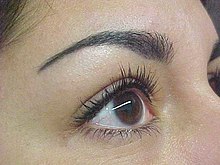Permanent make up
Permanent make-up (PMU) (also pigmentation ) is the name for special cosmetic tattoos on the face, which can be used to create artificial eyelid lines or lip contours that will last for several years.
Applications
Permanent make-up includes:
- Eyebrows - contour, fill in, emphasize
- Lash line compression - eyeliner between the eyelash hairs
- Eyeliner - fine to strong lines for eyeliner
- Lipliner - shape, enlarge or reduce the contour
- Lip color replenishment - fill in lips completely
- Nipple Redesign - Nipple Imitation
- Apply a beauty mark
history
Cosmetic tattoos are known to many peoples. For example , the lips of the women of the Japanese natives, the Ainu , were tattooed darkly, and the lips of the women of the New Zealand Maori were included in the ornamental chin tattoo ( Ta Moko ). Red lips were often viewed as unsightly. In all cases, the readily available charcoal - ground to a fine powder - was used as the pigment.
Among the Vikings, the Jewish-Arab traveling salesman Ibrahim ibn Yaqub mentions after a visit to Schleswig [translation by Georg Jacob]:
" There is also an artificially made eyeshadow; when you use it, the beauty never diminishes, but increases, in both men and women ,"
A colleague of the translator and editor contradicts this translation in footnote 9) , and instead suggests:
" If it remains (the eyeshadow) and does not disappear like the ordinary khol , which always has to be renewed, "
The latter translation is certainly the more accurate given the ready availability of charcoal pigment and tattooing instruments (e.g. with needles made from plant thorns or herringbones), as well as the worldwide spread of tattoos. Apparently, tattooed eyelid lines were already widespread in women and men in Central and Northern Europe in the early Middle Ages.
The first, scientifically proven, cosmetic tattoos of recent times were made by the tattoo artist Horst Klassenbach from 1951. Straßenbach tattooed beauty marks, eyeliner lines, eyebrows and also eyeshadows . From 1976 work in the medical field was added. After breast cancer surgery, he performed the world's first nipple reconstruction . The process was called "Straßenbach - Technik" in the med. Literature taken over.
durability
It can be assumed that, depending on the skin type, an effective shelf life of two to five years will be achieved before the permanent make-up needs to be refreshed. In pigmentation, colors are introduced into the upper dermis with a fine needle . Claims that the shorter durability compared to more common tattoos is due to the fact that the pigments are introduced more superficially is incorrect in view of the renewal of the epidermis within 4-6 weeks. The shorter shelf life is more the result of the lower total amount of the pigments introduced, which are distributed correspondingly faster in the tissue or are transported away into the lymph nodes due to a smaller particle size .
The permanent make-up fades like classic tattoos after a while. Colors with organic pigments can also change their original color, in contrast to mineral pigments.
Risks
Risks include tightness, redness, swelling, lymph leakage after the procedure, inflammation, infections, permanent scars, allergic skin reactions and the outbreak of cold sores.
If the pigmentation color contains iron oxide , there is a risk during subsequent MRI examinations that the areas where the permanent make-up was applied will become uncomfortably heated and cause redness, swelling or slight burns. In particular, permanent make-up applied to the eye must therefore be notified to the radiologist beforehand; an MRI examination may then have to be canceled.
See also
literature
- Paola Piccinini, Laura Contor, Ivana Bianchi, Chiara Senaldi, Sazan Pakalin: Safety of tattoos and permanent make-up , Joint Research Center , 2016, ISBN 978-92-79-58783-2 , doi: 10.2788 / 011817 .
- Georg Jacob [ed. u. Transl.]: Arab reports from ambassadors to Germanic royal courts from the 9th and 10th centuries . Translated into German and provided with footnotes by Georg Jacob , Berlin, Leipzig 1927. Digitized edition of the University and State Library in Düsseldorf
Web links
- Treatment of the week: Permanent make-up. Express.co.uk, accessed September 2, 2012 .
- Video of a permanent make-up treatment for the eyebrows. Retrieved February 11, 2016 .
Individual evidence
- ^ Paul-Henri Campbell : Tattoo & Religion. The colorful cathedrals of the self. Section: Manfred Kohrs making history, writing history. Heidelberg 2019, ISBN 978-3-88423-606-2 , p. 89.
- ↑ Obstetrics and Women's Health Dogs , Volume 36, Issue 1, 1976 page 13.
- ↑ Permanent make-up: Always beautiful? Brigitte.de, accessed on September 2, 2012 .
- ↑ a b Implants in MRI examinations. (PDF; 45 kB) Retrieved April 14, 2013 .
- ↑ Patient information sheet and information about MRI examinations (magnetic resonance imaging). (PDF; 48 kB) Retrieved April 14, 2013 .

